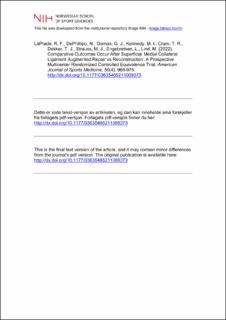| dc.contributor.author | LaPrade, Robert F. | |
| dc.contributor.author | DePhillipo, Nicholas | |
| dc.contributor.author | Dornan, Grant J. | |
| dc.contributor.author | Kennedy, Mitchell I. | |
| dc.contributor.author | Cram, Tyler R. | |
| dc.contributor.author | Dekker, Travis J. | |
| dc.contributor.author | Strauss, Marc Jacob | |
| dc.contributor.author | Engebretsen, Lars | |
| dc.contributor.author | Lind, Martin | |
| dc.date.accessioned | 2022-05-03T09:52:22Z | |
| dc.date.available | 2022-05-03T09:52:22Z | |
| dc.date.created | 2022-03-23T08:55:39Z | |
| dc.date.issued | 2022 | |
| dc.identifier.citation | American Journal of Sports Medicine. 2022, 50(4), 968-976. | en_US |
| dc.identifier.issn | 0363-5465 | |
| dc.identifier.uri | https://hdl.handle.net/11250/2993851 | |
| dc.description | Dette er siste tekst-versjon av artikkelen, og den kan inneholde små forskjeller fra forlagets pdf-versjon. Forlagets pdf-versjon finner du på journals.sagepub.com / This is the final text version of the article, and it may contain minor differences from the journal's pdf version. The original publication is available at journals.sagepub.com | en_US |
| dc.description.abstract | Background: Although previous studies have reported good short-term results for superficial medial collateral ligament (sMCL) reconstruction, whether an augmented MCL repair is clinically equivalent remains unclear.
Purpose/Hypothesis: The purpose of this study was to compare clinical outcomes between randomized groups that underwent sMCL augmentation repair and sMCL autograft reconstruction. The hypothesis was that there would be no significant differences in objective or subjective outcomes between groups. Study Design: Randomized controlled trial; Level of evidence, 1.
Methods: Patients were prospectively enrolled between 2013 and 2019 from 3 centers. Grade III sMCL injuries were confirmed via stress radiography. Patients were randomized to anatomic sMCL reconstruction versus augmented repair with surgical treatment, determined after examination under anesthesia confirmed sMCL incompetence. Postoperative visits occurred at 6 weeks and 6 months for repeat evaluation, with repeat stress radiography at final follow-up. Patient-reported outcome measures were obtained pre- and postoperatively at 6 months, 1 year, and final follow-up. The primary outcome measure was side-to-side difference on valgus stress radiographs at a minimum follow-up of 1 year. The two 1-sided t test procedure was used to test clinical equivalence for side-to-side difference in valgus gapping, and the Mann-Whitney U test was used to compare postoperative patient-reported outcome measures between groups. Results: A total of 54 patients were prospectively enrolled into this study. Of these, 50 patients had 6-month stress radiograph data, while 40 had 1-year postoperative valgus stress radiograph data. The mean (SD) patient age was 38.0 years (14.2), and body mass index was 25.0 (3.6). Preoperative valgus stress radiographs demonstrated 3.74 mm (1.1 mm) of increased side-to-side gapping overall, while it was 4.10 mm (1.46 mm) in the MCL augmentation group and 3.42 mm (0.55 mm) in the MCL reconstruction group. Postoperative valgus stress radiographs at an average of 6 months were obtained in 50 patients after surgery, which showed 0.21 mm (0.81 mm) for the MCL augmentation group and 0.19 mm (0.67 mm) for the MCL reconstruction group (P = .940). At final follow-up (minimum 1 year), median (interquartile range) Lysholm scores were significantly higher in the reconstruction group (90 [83-99]) as compared with the repair group (80 [67-92]) (P = .031). Final International Knee Documentation Committee (IKDC) scores were also significantly higher for the reconstruction group (85 [68-89]) versus the repair group (72 [60-78] (P = .039). Postoperative Tegner scores were not significantly different between the repair group (5 [3.5-6]) and the reconstruction group (5.5 [4-7]) (P = .123). Patient satisfaction was also not significantly different between repair (7.5 [5.75-9.25]) and reconstruction groups (9.0 [7-10]) (P = .184).
Conclusion: This study found no difference in objective outcomes between an sMCL augmentation repair and a complete sMCL reconstruction at 1 year postoperatively, indicating equivalence between these procedures. Patient-reported clinical outcomes favored the reconstruction over a repair. In addition, this study demonstrated that anatomic-based treatment of MCL tears with an early knee motion program had a very low risk of graft attenuation and a low risk of arthrofibrosis. | en_US |
| dc.language.iso | eng | en_US |
| dc.subject | medial collateral ligament | en_US |
| dc.subject | MCL augmentation | en_US |
| dc.subject | MCL reconstruction | en_US |
| dc.subject | MCL repair | en_US |
| dc.subject | randomized controlled trial | en_US |
| dc.title | Comparative Outcomes Occur After Superficial Medial Collateral Ligament Augmented Repair vs Reconstruction: A Prospective Multicenter Randomized Controlled Equivalence Trial | en_US |
| dc.title.alternative | Comparative Outcomes Occur After Superficial Medial Collateral Ligament Augmented Repair vs Reconstruction: A Prospective Multicenter Randomized Controlled Equivalence Trial | en_US |
| dc.type | Peer reviewed | en_US |
| dc.type | Journal article | en_US |
| dc.description.version | acceptedVersion | en_US |
| dc.source.pagenumber | 9 | en_US |
| dc.source.journal | American Journal of Sports Medicine | en_US |
| dc.identifier.doi | 10.1177/03635465211069373 | |
| dc.identifier.cristin | 2011853 | |
| dc.description.localcode | Institutt for idrettsmedisinske fag / Department of Sports Medicine | en_US |
| cristin.ispublished | true | |
| cristin.fulltext | postprint | |
| cristin.qualitycode | 2 | |
